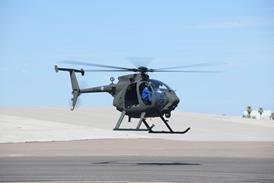Tu-154M
The Tu-154M is the current production version of the 160- to 180-seat Tu-154 TriJet, which was first flown in October 1968. Initial versions (the Tu-154, -154A and -154B-2) were equipped with Kuznetsov NK-8 engines. The Tu-154M was announced in 1983, powered by Aviadvigatel D-30KU turbofans and featuring increased weights. The first Tu-154M was delivered to Aeroflot in late 1984, and around 400 have been built to date. All Tu-154s have the same fuselage length, with accommodation for 168-180 passengers, depending on layout. A cargo conversion, called the Tu-154S, with a large freight door on the forward fuselage, is also in service. The aircraft will be replaced in production by the Tu-204.
A twin-engined version of the Tu-154 had been proposed, dubbed the Tu-154M2, which would have been equipped with the Perm PS-90, and feature a 2m stretch. The development of this aircraft is thought to have now been suspended.
Tu-204/214/224
The twin-engined Tupolev Tu-204 was first flown in January 1989, and The type was certificated by the Russian authorities in January 1995. ARIA received its first Tu-204, a -204C freighter, in April 1995. The initial version (the Tu-204-100) is powered by the Perm PS-90 engine, and a higher-weight model, equipped with the PS-90, has also now been developed. This is designated the Tu-214 (formerly the Tu-204-200). A Westernised R-R RB211-powered variant (dubbed the Tu-224, previously the Tu-204-120/-220) is also offered, and the first R-R-powered model flew in August 1992.
Aviastar Asia (AAC), a joint venture involving Aviastar and several South-East Asian financial institutions, opened its office in Taipei, Taiwan, in July 1996. The consortium will provide leasing, financial and technical support for the Tu-204. AAC is expected to place an order for 20 Tu-204s, with the deal including both the Perm PS-90 and R-R RB.211-powered versions, and the Tu-234. AAC aims to place Tu-204s in what is perceived as the traditional Russian-airliner markets - Africa, Asia, the CIS, Eastern Europe, the Middle East and the Pacific rim.
The R-R-powered Tu-224 was revived in August 1996 when Egyptian company Kato Group placed orders and options for 30 aircraft, and committed to up to 200 units over the ensuing five years. Kato is negotiating with Rockwell-Collins, AlliedSignal and Honeywell on the avionics suite. Kato plans to create an international aerospace group which will market and support the Tu-224 worldwide. Russian certification of the Tu-224 is expected next year, with JAA approval following in 1998.
Production - The basic PS-90-powered Tu-204, R-R-powered Tu-224 and short-fuselage Tu-234 are built by Aviastar at its plant in Ulyanovsk. During 1996, production has been interrupted by funding problems, with all assembly work halted while Aviastar sought Government guarantees to fund the completion of aircraft. Aviastar is targeting a production rate of six aircraft a month by 2001. A second assembly line has been set up in Kazan for production of the higher weight Tu-214.
Tu-234
Tupolev unveiled the Tu-234 in September 1995, a shortened version of its Tu-204 medium-range airliner. Formerly known as the Tu-204-300, the aircraft is powered by Aviadvigatel PS-90A turbofans and seats 160 passengers.
The Tu-234 has a fuselage 6m shorter than that of the Tu-204, and the prototype, which was created by the conversion of a Tu-204, was rolled out at Zhukovsky, Moscow, in August 1995.
This aircraft has not been flown, however, and the first production aircraft has now been completed by Aviastar. The timetable of the aircraft has been subject to many delays due to funding problems.
Production - See Tu-204.
Tu-304
Tupolev revealed details of its planned Tu-304 long-range widebodied twin in August 1995, adding that it has signed a protocol with R-R to power the aircraft with the 400kN Trent 884 turbofan.
If funding is obtained, prototype construction is expected to begin in late 1998, with the maiden flight scheduled for the beginning of 2000. The company expects the aircraft to be certificated at the end of 2001.
The Tu-304 is planned to have a maximum capacity in single-class seating of 400 passengers, with alternative two- and three-class configurations down to 312 seats. It will have a laminar-flow wing, allowing a Mach 0.85 cruise, a range with 400 passengers of 10,200km, and a maximum take-off weight of 245t.
Tu-330
The Tu-330 freighter, powered by two Perm PS-90A turbofans, is due to have its first flight in 1997 and to enter service in 1998. The aircraft has a high wing and a cargo ramp, and is provided with loading and unloading equipment for autonomous operation. It is derived from the Tu-204, with which it shares the wing, pylons and tail section, as well as systems. Tupolev is pitching the aircraft at the An-12 replacement market.
Tu-334
The twin-engined Tu-334 was conceived for CIS service as a much-needed Tu-134 replacement. The aircraft is designed to carry 102 passengers on routes of up to 3,000km.
Equipped with two rear-mounted D-436T turbofans, the Tu-334-100 prototype was rolled out in August 1995, at the same time as the Tu-234, and certification had been scheduled for 1997. Like many Russian aircraft programmes, however, it has been hampered by funding problems, and the first aircraft has yet to be flown.
A preliminary agreement has been struck with BMW R-R to offer the stretched 126-seat -200 version of the aircraft with the BR715 engine, rated at 89kN thrust. A -100D long-range derivative is also planned, and the two later versions will feature an increased MTOW of 54.8t, and a wing area increased to 100m2, compared with 83.2m2 on the -100.
The Tu-334 is fitted with a Russian-made glass cockpit, which has a high degree of commonality with the Tu-204 cockpit. Tupolev aims to install Western avionics to boost the type's export potential, however.
Production - Series production of the Tu-334 will be undertaken at plants in Kiev and Taganrog.
Source: Flight International























